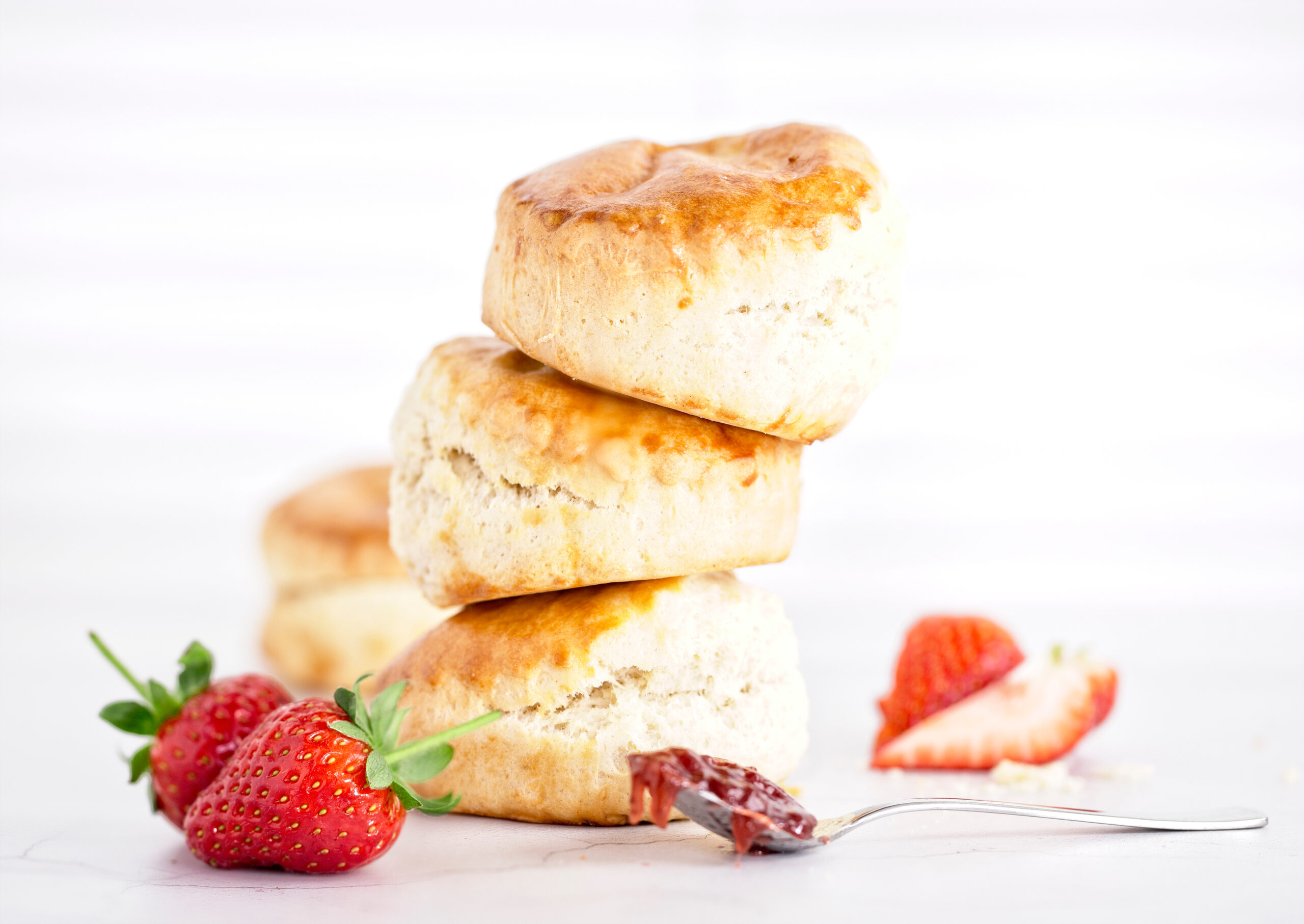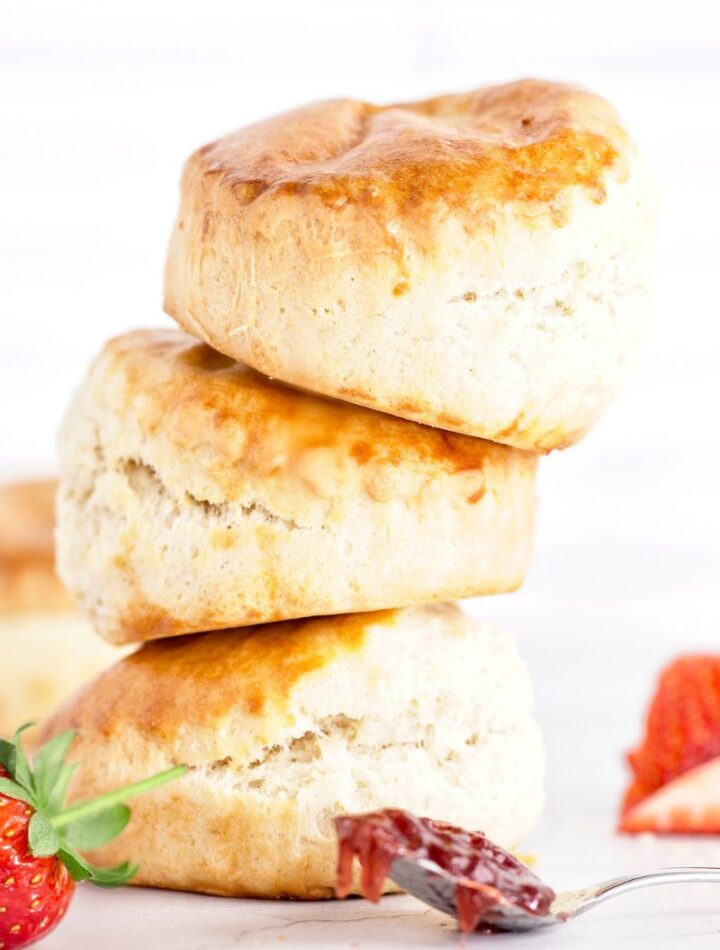From my vantage point, it seems to me that America took everything British and tweaked it just enough to put an exclamation mark on “Don’t forget who the rebels are…” We put our steering wheel on the opposite side of the car, we drive on the opposite side of the road, our patriotic song “My County Tis of Thee” is set to the same tune as England’s “God Save the Queen (King). And instead of lightly sweet, flakey, round Scones we produced a much sweeter, crumbly, triangular Scone. And sometimes we serve our Scone with icing on top, leaving little room for clotted cream or jam or lemon curd, also things we discarded along the way.
The British version of a Scone (pronounced both Scone and Skon-rhymes with gone-in Britain) are typically made of wheat flour, baking powder, salt, butter and milk or cream. They are tender and rich and if I had to speak as a true Mid-Westerner from the US, I think they resemble most a cross between pie crust and the shortcakes you would make using the recipe on the back of the “Bisquick” box. The Brits can sometimes get a little creative with their scones using different flours and adding golden raisins (sultanas), currants or savory ingredients such as cheese, onion and bacon but they are typically served plain with butter, jam and clotted cream and sometimes strawberries.
Scones are typically served in Britain at “cream tea” and are not a breakfast item like our biscuits. For great tips on how to host a cream tea see https://www.creamteasociety.co.uk/cream-teas. It is here I must briefly explain the cream in “cream tea”. Clotted cream is an integral part of scones in Britain. Like lemon curd, it doesn’t sound delicious but…it…is. Clotted cream is unique. We don’t really have anything super close to it in America. In my opinion it is the closest to butter in it’s consistency but has a “heavy cream” flavor-but not the pasturized version of heavy cream you get at the grocery story. If you grew up on a farm, the cream on top of your raw milk would give you a great idea of the flavor you will encounter with clotted cream–because that is essentially what it is. You can find jarred bottles of clotted cream at specialty food stores or online. If I have success making it in the future, I will share it with you because a small bottle can cost upwards of $8. Scones and cream tea are a huge part of Britain’s mid morning or afternoon break before dinner. And there is an ongoing dispute between Devon and Cornwall (counties in Southwest England) as to whether the clotted cream goes first on the Scone or the jam goes first. Like the battle between a pasty crimp on top or a pasty crimp on the side, it’s quite a serious debate. Since we crimp our pasties at London Calling the Cornish way I should fall on team Cornish as it pertains to the scone…the debate between Devon and Cornwall is serious enough that I am afraid to look at this video to see what side I actually fell on, which was most likely rebellious.
P.S. We don’t currently offer Scones at London Calling but how great would it be to offer them as a take and bake item! Any takers?

Traditional British Scones
Equipment
- 1 Medium Bowl
- 1 Large Sieve or Sifter To sift the flour
- 1 Round Biscuit Cutter
- 1 Whisk
- 1 Pastry Brush
- 1 Set Measuring Cups
- 1 Set Measuring Spoons
- 1 Spoon
- 1 Small Knife To Cut the butter into pieces and level the flour
- 1 Sheet Pan
- Parchment Paper You can also grease your sheet pan instead of using parchment
Ingredients
- 2 Cups Unbleached All Purpose Flour Measure using a spoon and level off with a knife.
- 2 Tablespoons Granulated Sugar
- 4 Teaspoons Baking Powder Be careful to not used Baking Soda by mistake in this recipe
- 1/2 Teaspoon Salt
- 3 1/2 Tablespoons Butter, Cold Cut into small pieces, Salted or Unsalted. Either works fine as far as taste.
- 2/3 Cup Milk, Whole Add more if needed a Tablespoon at a time.
- 1 Medium Egg, Whisked For the Glaze
- 1 Tablespoon Milk For the Glaze
Instructions
- Preheat the oven to 425F (You will lower the temperature before baking)
- In a medium bowl whisk the 2 cups flour, the 2 Tbls sugar, the 4 Tbls baking powder and the 1/2 tsp salt. OR You can also add all the ingredients to a large sieve over the bowl and lightly tap the sides of the sieve and the ingredients will mix nicely right into the bowl and add air and therefore lift to your scones.
- Add the 5 Tbls butter and use your fingers to rub the butter into the flour mixture until it looks like sand
- Add the 2/3rd cups milk. Mix lightly with your hands until the mixture starts to come together without lumps. The dough should be a little sticky. You can add more milk a Tablespoon at a time if your flour mixture is not coming together. Different flours and humidity can cause differences in liquid needs.
- Place the dough on a well floured surface. Press, fold, and turn the dough gently 2-3 times. Press the dough into a round that is 1/2 inch to 3/4inch thick.
- Place your round biscuit cutter into flour and cut out 4 circles. Take the remaining dough scraps and work with it gently to form another dough disk and cutout the final scone. Twisting the cutter (and therefore sealing the edges) can keep the scone from rising properly.
- Whisk the 1 egg and the 1 Tablespoon of milk together to form the glaze. With the pastry brush, brush the uncooked scones with the glaze. This will create a nice golden brown top on your finished scone.
- Line the baking sheet with parchment paper or grease the baking sheet and place the scones on the baking sheet
- Reduce oven temperature to 400 degrees F.
- Bake the scones for 15-17 minutes or until golden brown
- Top with room temperature clotted cream and strawberry jam or lemon curd and enjoy!

